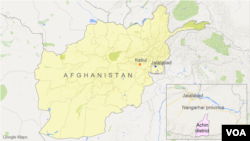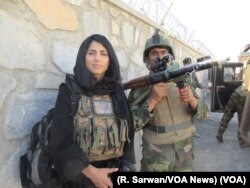The so-called Islamic State group has sprung up and gained ground in eastern Afghanistan’s Nangarhar province this year.
News from the area was spotty at best. No one was sure who the militants were. Afghans? Foreigners? Disgruntled Taliban? Where did they come from? What were they up to? What was the situation on the ground?
Locals seemed to be scared and fleeing. Officials were hesitant to admit the extent of the problem.
A VOA colleague and I decided to check things out for ourselves. With me were cameraman Rahim Gul Sarwan and a local fixer, whose identity I will not reveal for security reasons.
Complex planning
The first step was planning – days of it. We had plans, then back-up plans, then back-ups for the back-up plans, knowing full well that most of those plans could fall apart at any time.
Not only were we going to Nangarhar province, the Islamic State (IS) militants’ hub, but we were going to Achin district, their stronghold.
IS was not our only problem. Decades of conflict, a weak government and security forces stretched thin as a snare drum – combined with the presence of foreigners seen as flush with cash – have turned Afghanistan into a haven for criminals. Kidnappings for ransom are a major concern. If you look like someone who has money, you are a target. If you look like a foreigner, you are a bigger target.
Other hazards, like roadside bombs and suicide attacks, are more random and harder to mitigate. But this is Afghanistan. You can get hit by shrapnel on your way to a cafe, so you learn to cope with the fear.
We decided on a beat-up Toyota Corolla, a staple in Afghanistan, as our transportation. No one would take a second look at it.
Then we needed another vehicle: the right cover story, with fake IDs to match.
We didn’t want to reveal our identities to hotel staff or local police at checkpoints. Word of a visiting foreign journalist could spread quickly, perhaps to an IS spy or criminals looking for targets.
My South Asian looks helped. If I wore local clothing and kept my mouth shut, I could pass as Afghan. I put on an abaya, or long black robe, and kept my face covered most of the time with a hijab or a black scarf. Only my eyes were visible. With my Afghan cameraman and fixer, we could pass as a local family.
Jalabad as a proving ground
Our first stop was Nangarhar’s capital, Jalalabad. We picked a low-profile hotel, not a place where foreigners or the wealthy stay, and asked for rooms on the second floor. That would give us time to respond in case of an attack, but keep us close enough to the ground to be able to jump and run if we had to.
Jalalabad is much more conservative than the country's capital, Kabul. A woman standing in front of a camera, even in an abaya, would stick out, so we couldn’t do any street shots until the last day. We finished all indoor shooting first and planned street shots that could be finished in less than 10 minutes, and then left for Kabul right away. Throughout the drive, we watched our rearview mirror to make sure no one was following.
On to Achin
But the trip to Achin proved even more nerve-racking. IS militants have established safehavens in the district, from which they plan and mount attacks on surrounding areas, capturing and beheading hundreds of locals. They probably had spies among the population. Our plan was to be invisible as we approached. Be local. Be part of the landscape.
That included managing my bodily needs. Once we left our Jalalabad hotel, using the toilet was not an option. Public toilets for women are rare in Afghanistan anyway. In a mostly rural area like Achin, they would be difficult to find. And if I found one, I’d risk having to interact with a local. That could blow our cover because I don’t speak the local language, Pashto. So I drank as much as possible the night before and relied on chewing gum to quench my thirst for most of the day, until we could reach safety.
We also knew that the moment we took out our camera or started talking to locals about IS in Achin, our cloak of invisibility would be gone, so we needed protection there and on the way back.
More security measures
Sarwan, who has become somewhat of a security expert himself after traveling and reporting from so many dangerous areas, knew the district governor, Haji Ghalib. A former mujahid who had fought the Russians and then the Taliban, Ghalib had become a bit of a local media celebrity for his bravery in taking on IS militants. He would provide us security in Achin and escort us back to the highway.
We got more security than we had expected. Zabiullah Zmaray, a Nangarhar provincial council member whom we had interviewed, also agreed to accompany us to the district. He was another of the few local leaders who spoke up against IS in public, making him a target. Plus, he was an archetypal Afghan host – and I was now his guest. He was not going to take any chances, either with his life or mine.
So, when we set out for Achin, we found two armored cars and dozens of men in bulletproof vests and fully loaded AK-47s waiting for us. On the road, we were joined by Afghan National Army troops, men in armored Humvees with rocket-propelled grenades. Had I just been elected president of the country? This was the most impressive VIP treatment I had ever received.
But the entourage meant that our VOA team no longer was invisible. I couldn’t help but remember that some people in this region had been attacked by their own guards. I quietly patted my pockets for items I might need if I had to make a run for it: tracker, backup phone, emergency numbers; local currency.
Unbeknownst to our armed hosts, our local fixer was following at a safe distance in another beat-up Corolla, different from the one we’d used to travel to Jalalabad. In case of an ambush, he would be a phone call away.
Dangerous road
Achin is a dusty place. The main road into the district leads through areas that have witnessed fighting between IS and Taliban. The driver told me that one bazaar on the way was considered particularly dangerous because militants sometimes throw grenades at moving cars.
As we traveled to our final destination – the police checkpoint where the Afghan government’s writ ended – my fellow passengers pointed out holes in the road where explosive devices had recently blown up vehicles.
By this time, we had left the armored cars behind and I was in an armored Humvee, clad in an abaya topped by a bulletproof vest. As soon as we got out of the Humvee, we were told to duck and run behind the checkpoint barriers. Apparently, IS had long-range sniper rifles they had used to kill soldiers at that post.
In the end, we got multiple stories and lived to tell them. We got a clearer picture of the IS presence in the area, as well as the group's brutal, repressive tactics and how they’re affecting local people. Would I take the risk again? In a heartbeat.









